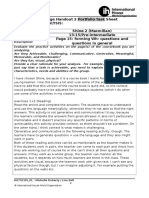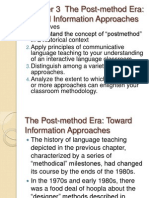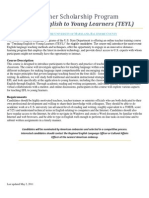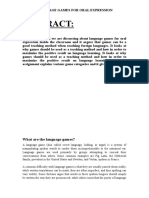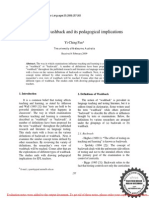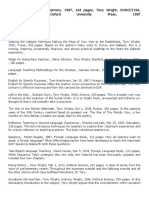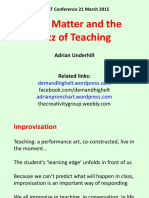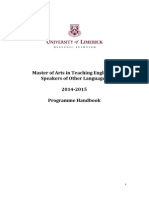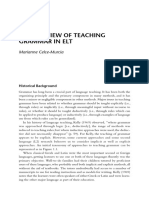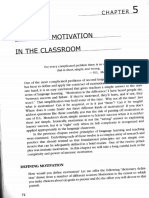0 ratings0% found this document useful (0 votes) 155 views9 pagesLanguage Teaching
Copyright
© © All Rights Reserved
We take content rights seriously. If you suspect this is your content,
claim it here.
Available Formats
Download as PDF or read online on Scribd
Language Teaching Approaches:
An Overview!
MARIANNE CELCE-MURCIA
In “Language Teaching Approaches: An Overview,” Celce-Murcia gives some historical background,
then outlines the principal approaches to second and foreign language teaching that were used during
the twentieth century. She previews the book as a whole and projects some trends for language
instruction in the new millennium,
INTRODUCTION
The field of second (or foreign) language teach-
ing has undergone many fluctuations and shifts
over the years. Different from physics or chem-
istry, in which progress is more or less steady
until a major discovery causes a radical theoreti-
cal revision (Kuhn 1970), language teaching is a
field in which fads and heroes have come and
a gone in a manner fairly consistent with the kinds
: of changes that occur in youth culture. I believe
that one reason for the frequent swings of the
pendulum that have been taking place until fairly
recently is the fact that very few language teachers
have a sense of history about their profession and
are thus unaware of the historical bases of the
many methodological options they have at their
disposal. It is hoped that this brief and neces-
sarily oversimplified survey will encourage many
language teachers to learn more about the ori-
gins of their profession. Such knowledge will
ensure some perspective when teachers evaluate
any so-called innovations or new approaches
© to methodology, which will surely continue to
‘merge from time to time.
Pre-twentieth-Century Trends:
A Brief Survey
‘of approaches: getting learners to use a language
(hes, to speak and understand it) versus getting
~ Itamers to analyze a language (ie., to learn its
{rammatical rules).
Both the classical Greek and medieval Latin
periods were characterized by an emphasis on
teaching people to use foreign languages. The
classical languages, first Greek and then Latin,
were used as lingua francas. Higher learning was
conducted primarily through these languages all
over Europe. They were used widely in philoso-
phy, religion, politics, and business. Thus the
educated clite became fluent speakers, readers,
and writers of the appropriate classical language.
‘We can assume that the teachers or tutors used
informal and more or less direct approaches (0
convey the form and meaning of the language
they were teaching and that they used aural-oral
techniques with no language textbooks per se,
but rather a small stock of hand-copied written
manuscripts of some sort, perhaps a few texts in
the target language, or crude dictionaries that
listed equivalent words in two or more languages
side by side.
During the Renaissance, the formal study
of the grammars of Greek and Latin became
popular through the mass production of books
made possible by the invention of the printing
press. In the case of Latin, it was discovered that
the grammar of the classical texts was different
from that of the Latin being used as a lingua
franca—the latter subsequently being labeled
vwulgate Latin, i.e., Latin of the common people.
Major differences had developed between the
classical Latin described in the Renaissance
grammars, which became the formal object of
instruction in schools, and the Latin being used
for everyday purposes. This occurred at about
the same time that Latin began to be abandoned
3�as a lingua franca. (No one was speaking classi-
cal Latin anymore, and various European ver-
naculars had begun to tise in respectability and
popularity.) Thus, in retrospect, strange as it
may seem, the Renaissance preoccupation with
the formal study of classical Latin may have con-
tributed to the demise of Latin as a lingua franca
in Western Europe.
Since the European vernaculars had grown
in prestige and utility, it is not surprising that
people in one country or region began to find it
necessary and useful to learn the language of
another county or region. Thus the focus in lan-
guage study shifted back to utility rather than
analysis during the seventeenth century. Pethaps
the most famous language teacher and method-
ologist of this period is Johann Amos Comenius,
a Czech scholar and teacher, who published
books about his teaching techniques between
1631 and 1658. Some of the techniques that
‘Comenius used and espoused were the following:
= Use imitation instead of rules to teach a
language.
= Have your students repeat after you.
Use a limited vocabulary initially.
™ Help your students practice reading and
speaking.
= Teach language through pictures to make it
meaningful.
‘Thus Comenius, perhaps for the first time,
made explicit an inductive approach to learning
a foreign language, the goal of which was to
teach use rather than analysis of the language
being taught.
‘Comenius’s views held sway for some time;
however, by the beginning of the nineteenth cen-
tury, the systematic study of the grammar of clas-
sical Latin and of classical texts had once again
taken over in schools and universities through-
out Europe. The analytical GrammarTranslation
Approach became firmly entrenched as a method
for teaching not only Latin but, by extension,
modem languages as well. It was perhaps best
codified in the work of Karl Ploetz, a German
scholar who had a tremendous influence on the
language teaching profession during his lifetime
and afterwards. (He died in 1881.)
Pt tt
However, the swinging of the pendulum
continued. By the end of the nineteenth century,
the Direct Method, which once more stressed
the ability to use rather than to analyze a
language as the goal of language instruction,
had begun to function as a viable alternative
to Grammar‘Translation. Francois Gouin, a
Frenchman, began to publish in 1880 concern-
ing his work with the Direct Method. He adyo-
cated exclusive use of the target language in
the classroom, having been influenced by an
older friend, the German philosopherscientist
Alexander von Humboldt, who had espoused the
notion that a language cannot be taught, that
cone can only create conditions for learning to
take place (Kelly 1969).
The Direct Method became very popular
in France and Germany, and has enthusiastic
followers among language teachers even today
(as does the Grammar Translation Approach).
In 1886, during the same period that the
Direct Method first became popular in Europe,
the International Phonetic Association was
established by scholars such as Henry Sweet,
‘Wilhelm Viétor, and Paul Passy. They developed
the International Phonetic Alphabet (IPA) and
became part of the Reform Movement in lan-
guage teaching in the 1890s. These phoneticians
made some of the first truly scientific contribu-
tions to language teaching when they advocated
principles such as the following:
™ the spoken form of a language is primary
and should be taught first;
= the findings of phonetics should be applied
to language teaching;
language teachers must have solid training
in phonetics;
@ learners should be given phonetic training
to establish good speech habits.
‘The work of these phoneticians focused on the
teaching of pronunciation and oral skills,
which they felt had been ignored in Grammar-
‘Translation. Thus, although the Reform Move-
ment is not necessarily considered a full-blown
pedagogical approach to language teaching, its
adherents did have an influence on future
approaches, as we shall see.
‘Unit I Teaching Methodology�Quite apart from the work of the Reform
Movement; the influence of the Direct Method
grew; it crossed the Antic in the early twentieth
century when Emile de Sauzé, a disciple of
Gouin, came to Cleveland, Ohio, in order to see
to it that all foreign language instruction in the
public schools there implemented the Direct
Method. De Sauzé’s endeavor, however, was not
completely successful (in Cleveland or else-
where) since there were too few foreign language
teachers in the United States. who were fluent
speakers of the language they taught. Later, the
Modern Language Association of America, based
on the Goleman Report (Coleman 1929),
endorsed the Reading Approach to language
teaching, since given the skills and limitations of
most language teachers, all that one could rea-
sonably expect was that students would come
away from the study of a foreign language able
to read the target Ianguage—with emphasis on
some of the great works of literature and philos-
‘ophy that had been produced in the language.
‘The Reading Approach, as reflected in the
work of Michael West (1941) and others, held
sway in the United States until the late 1930s and
‘early 1940s, when World War II broke out and
mace it imperative for the U.S. military to quickly
ind efficiently teach foreign language learners
how to speak and understand a language.
‘Al this time, the U.S. government hired linguists
‘to help teach languages and develop Laan
Ww heavily on structural linguistics Gloomfeld
(93)) and behavioral psychology (Skinner 1957),
horn. In Britain the same historical pressures
, Pittman 1963), which drew on Firthian
sulstics (codified in the work of Firth’s best-
by, Init less dogmatie than, its American
itr (the Audiolingual Approach), the
Situational Approach advocated organ-
fictures around situations that would
iching Approaches: An Overview
nonetheless often being little more than choral
repetition. Some historians of language teaching
(e4g., Howatt 1984) believe that the earlier Reform
Movement played a role in the development of
both Audiolingualism in the United States and
the Oral-Situational Approach in Britain
Nine Twentieth-Century Approaches
to Language Teaching
In addition to the Grammar-Translation Approach,
the Direct Approach,? the Reading Approach, the
Audiolingual Approach, and the Oral-Situational
Approach—whose historical development I have
sketched above briefly—there are four other
discernible approaches to foreign language
teaching that developed and were widely used
during the final quarter of the twentieth century.
‘Thus, there are nine approaches altogether that |
shall be referring t
1. GrammarTranstation
2. Direct
8 Reading
4, Audiolingualism (United States)
5. Oral Situational (Britain)
6. Cognitive
7, Affective- Humanistic
8 Comprehension-Based
9. Communicative
However, before listing the features of each
approach, I would like to digress a moment to
clarify some terminology that is crucial to this
discussion, Namely, what do we mean by the
terms approach, method, and technique? Ave these
terms synonymous? If not, how do they differ?
Anthony (1963) has provided a useful set of def
initions for our purposes. An approach to lan
guage teaching is something that reflects a
certain model or research paradigm—a theory,
ifyou like. This term is the broadest of the three.
‘A method, on the other hand, is a set of proce-
dures, ic., a system that spells out rather precise-
ly how to teach a second or foreign language.
It is more specific than an approach but less
specific than a technique. Methods are typically
compatible with one (or sometimes two)

